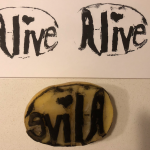4.4 Task 4: Manual Scripts and Potato Printing
Please view the Potato Carving here:
Chosen 5 letter word: alive

I chose to create a five-letter word stamp out of potatoes for Task 4. I have never made stamps before let alone from potatoes, so this process was challenging. I found that there was some planning and visual thought that needed to be set in place before beginning. Especially because the stamp needed to be of the word and not the silhouette of the word (the negative print). I found the carving particularly difficult as the tools I had were limited to a sharp blade and likely not appropriate or adequate for carving. I also found challenging trying to shape the letters particularly the letters that have a round or curved shape such as the letter “e.”. It was difficult to get the shape and letters to be smooth in the potato. Lastly, ensuring that I reversed all the letters so that when it would print it would be correct.
The entire process for making the stamps took almost 2 hours. I had no idea that it would involve so much time to create a five-letter word stamp. I was very surprised about th
e length of time and work involved just to create this word. There was the cutting of the potato, then drying, then planning the design of the word, carving, then drying overnight before finally printing the word. I began to understand, with a deep appreciation, just how much skill, time and effort it must have taken for people to letter print several hundreds of years ago. The video clip in Module 4 that showed the process of Letterpress Technology was still more advanced than hand-made stamps and letters. It is difficult to imagine how much work was involved in printing scripts and books many years ago.
I noticed that the letters I produced for the word, “alive,” were not very accurate in form and shape. I decided to carve the letters with a basic font and mostly lower case letters versus try to attempt cursive style or all capital letters. My decision was based upon thinking it would be more easily created if I kept it simple. This was a success as I would imagine trying to produce and cut out any other font of letters would be extremely challenging.
The mechanization of writing seems much more of an art in process compared to when you print something out that was generated by the computer. The fine details such as molding, stamping, the nuts and bolts involved in the scroll seemed so skilled. I can see why people would appreciate this method of printing. I was thinking while watching just how much time this consumes. I was surprised that letterpress technology centers are still in operation.
Literacy and the purpose of scriptures, “scriptoria” began mainly for recording teachings of the Bible. Writing for knowledge versus reading for knowledge in books is something I found interesting when listening to the audiobook, “How it Began.”
Some inquiries that came to mind as I was creating this stamp and from listening to the audiobooks and readings are:
-The health of eyes by monks (because they did so much writing in candlelight) compared to the health of eyes at our present time from all the usage of screens from technology.
-How handwriting and penmanship of students changes due to typing and screens
-How students are influenced by what they see as text (print) For example, graphic novels with in text all CAPITALS to highlight and enhance words to engage students -is this type of text influencing how students hand write and print
-What are the impacts on the environment- animal hide was used to write on in the 1400’s and now we use trees
-How has this changed the economy as we move toward more writing using technology

